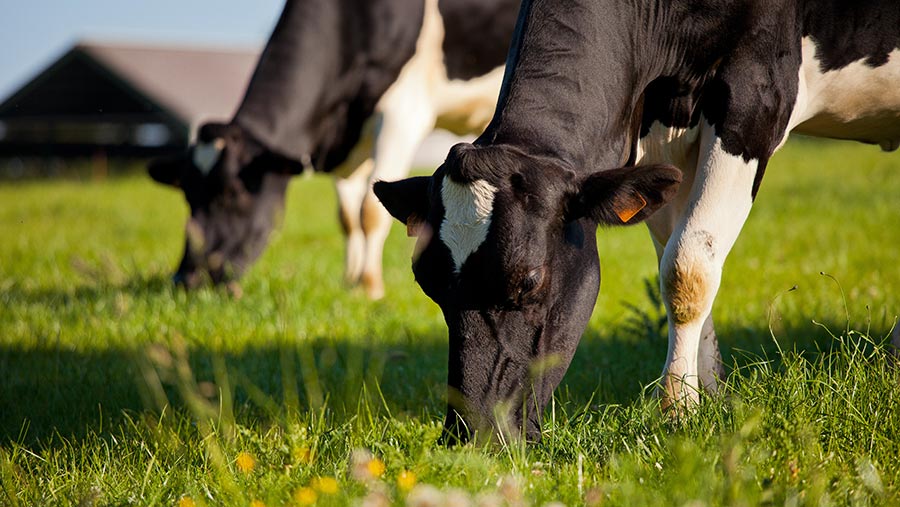Dairy financial KPIs: What they mean and when to use them
 © Adobe Stock
© Adobe Stock Every business should know financial measures so they can understand and benchmark business performance.
Oliver Hall and Jake Armstrong-Frost, consultants from The Andersons Centre, take us through the main ones and explain what they are and when to use them.
First, we need to look at a few standardisation points that occur when using them.
See also: 7 ways to lift profits on your dairy farm
Imputed labour costs
This is the cost of labour provided by the business owner to the farm business, which is not often reflected in the profit and loss accounts.
Different standardisations can occur and, ultimately, should reflect the cost of replacing this labour from the marketplace.
Andersons dairy discussion groups now work on £35,000 for 2,500 hours/year.
Machinery and infrastructure depreciation
This is the yearly reduction in asset value of items that are used in milk production.
The amount should reflect the replacement cost against the time it will last.
Assets can be divided up and grouped according to expected lifespan.
Four main financial KPIs
1. Full economic cost of production (COP)
What is it?
The total costs of the farm expressed per unit of production, which is normally per litre.
It gives a figure that is needed from milk and livestock sales to cover the full COP on that farm.
When to use it
For a quick benchmark against other dairy farmers and to benchmark against industry figures.
Andersons targets
No greater than 27p/litre if generating standard amounts of livestock from the dairy herd – ie, if you’re not generating surplus breeding stock.
2. Comparable farm profit (CFP)
What is it?
A standardised way of benchmarking your farm’s ability to create profit and to assess profitability of dairy farms with imputed labour and deprecation figures on a pre-rent and finance basis (standard subsidy not included).
When to use it
To benchmark against other dairy farmers on a comparable basis for all costs, not including providing land and capital to the business.
Alignment of cost codes can create the opportunity to benchmark all aspects of the business.
CFP can be expressed in numerous ways, including per litre, per kilogram of milk solids, per hectare, a cow and as a percentage of turnover.
Andersons targets
Profit of 10p/litre, £1,000/ha or 30% of turnover.
3. Breakeven analysis
Breakeven analysis can be done in a number of different comparative ways for a dairy business:
Breakeven milk price
What is it?
The milk price that your business needs to achieve a breakeven point of profit.
Calculated by taking all costs and deducting all other income apart from milk income to give the breakeven milk price needed.
When to use it
To evaluate the resilience of your business and a useful way to carry out a sensitivity check for future milk prices.
Andersons targets
Individual to each business, but serious questions should be asked if this is more than 26p/litre.
Breakeven cashflow milk price
What is it?
The milk price that your business needs to achieve a breakeven point of cashflow on a normalised yearly basis.
Differs from breakeven milk price as it uses actual capital reinvestment rather than depreciation and needs to pay after profit expenses, which include drawings, tax, and capital repayments on loans.
When to use it
When budgeting and planning. Shows how exposed your profits are and allows you to assess demands for profit versus milk price fluctuations.
Andersons targets
Questions need to be asked about cost and business structure if it is more than your five-year average milk price.
Care needs to be taken to have a realistic capital reinvestment amount.
Reinvestment should match the planned amount of depreciation over the different time periods of the assets, either by funding planned loans for those assets or saving up cash ready to reinvest.
4. Return on (tenant’s) capital (ROC)
What is it?
Your profit relative to tenant’s capital invested after a return for land and labour have been paid.
Expressed as a percentage. It is calculated: ROC = CFP profit – land rents / tenant’s capital employed (livestock + machinery + tenant’s infrastructure at average value (50% of replacement value)).
When to use it
When assessing a dairy business as an investment opportunity.
Makes profit relative to capital employed and helps avoid over capitalisation.
Andersons targets
Greater than 10%.
Comparison of what is included in the costings
|
|||||
| What’s included in the KPI? | Full economic cost of production | Comparable farm profit | Breakeven milk price | Breakeven cashflow milk price | |
| Expenses | Variable costs | ✅ | ✅ | ✅ | ✅ |
| Overhead costs | ✅ | ✅ | ✅ | ✅ | |
| Inputted labour costs | ✅ | ✅ | ❌ | ❌ | |
| Machinery and infrastructure deprecation | ✅ | ✅ | ✅ | ❌ | |
| Inputted land rental costs | ✅ | ❌ | ❌ | ❌ | |
| Actual land rent costs |
❌ | ❌ | ✅ | ✅ | |
| Interest on loans | ❌ | ❌ | ✅ | ✅ | |
| Capital repayments on loans |
❌ | ❌ | ❌ | ✅ | |
| Capital expenditure | ❌ | ❌ | ❌ | ✅ | |
| Drawings | ❌ | ❌ | ❌ | ✅ | |
| Tax | ❌ | ❌ | ❌ | ✅ | |
| Income | Milk income | ❌ | ✅ | Back calculated | |
| Livestock sales | ❌ | ✅ | ✅ | ✅ | |
| Subsidies | ❌ | ❌ | ✅ | ✅ | |
| Valuation change | ❌ | ✅ | ✅ | ❌ | |
